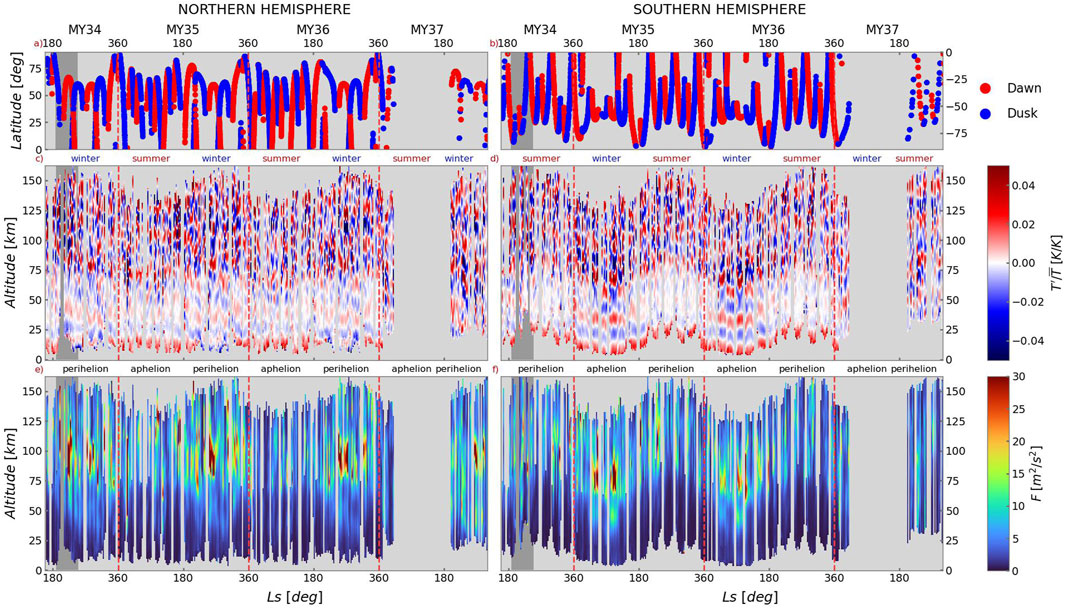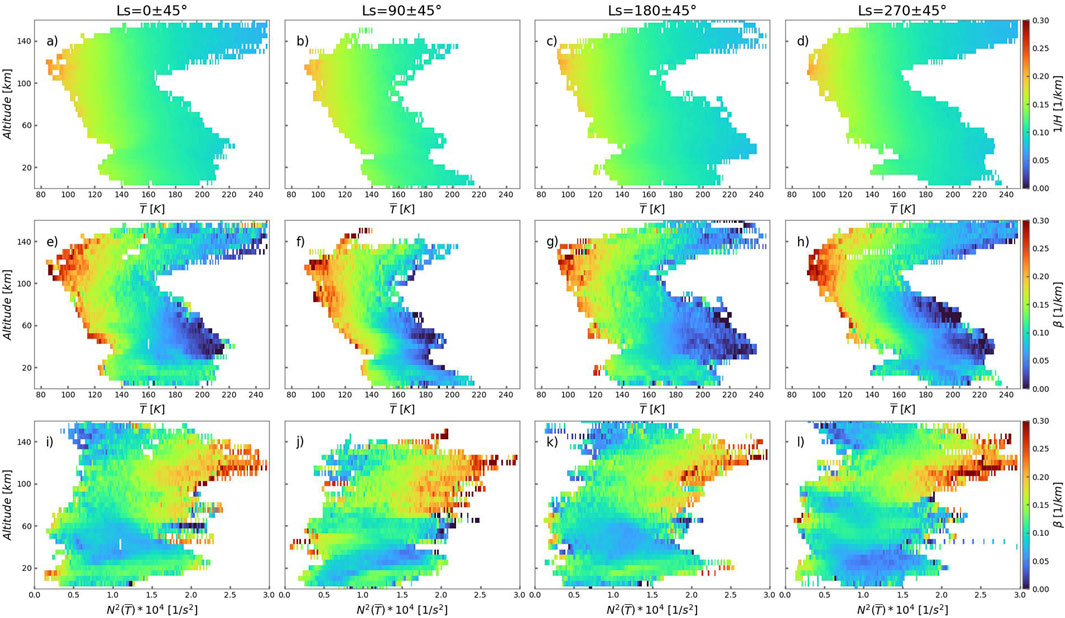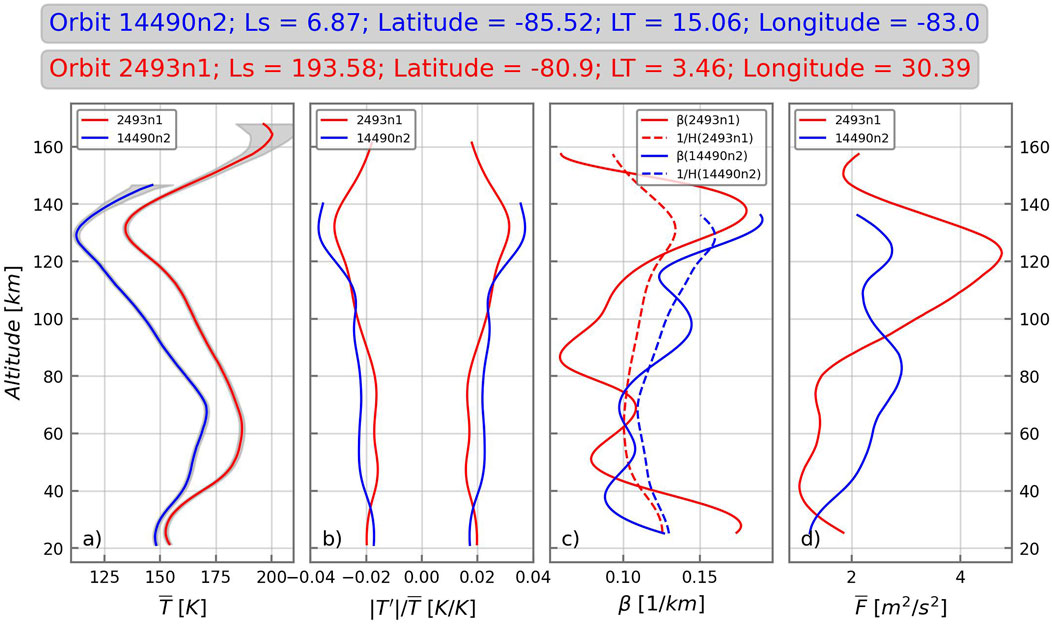- 1Space Research Institute of the Russian Academy of Sciences (IKI), Moscow, Russia
- 2Max Planck Institute for Solar System Research, Göttingen, Germany
- 3LATMOS/CNRS, Guyancourt, France
Amplitudes of gravity waves generated in the lower and denser atmospheric layers grow exponentially with height as they propagate to the upper and thinner atmosphere, where they are reduced by various processes. Their vertical decay is accompanied by a transfer of wave momentum and energy to the ambient flow, which represents a significant force in the upper atmosphere. Constraining the vertical damping and elucidating the related mechanisms are crucial for understanding the dynamics. Previous observations of gravity waves in the Martian thermosphere by different instruments provided evidence that amplitudes of relative temperature disturbances are inversely proportional to the mean temperature. This suggests that wave amplitudes may be limited by convective instabilities. However, this anticorrelation was not observed at all heights or in all measurements, sparking a discussion about the dominant mechanisms of wave damping. Using vertical temperature profiles collected by the Atmospheric Chemistry Suite instrument on board Trace Gas Orbiter over more than 6 years, we examined the statistical behavior of wave amplitudes and their vertical damping rates. We found a weak anticorrelation near the mesopause (
1 Introduction
Gravity waves (GWs) are maintained by a balance of two forces: gravity and buoyancy. Therefore, they are a common feature of all convectively stable planetary atmospheres (e.g., see reviews by Medvedev and Yiğit (2019); Yiğit and Medvedev (2019)). These waves redistribute energy, heat and momentum across vertical layers, thus playing an important role in the dynamics of the middle and upper atmospheres. Characterizing the GW fields is therefore essential for understanding the dynamics and constraining GW parameterizations in numerical general circulation models, thereby improving their predictive capabilities.
Numerous observations performed from Martian orbiters have provided a substantial amount of information about GWs in the atmosphere of Mars. One challenging and debatable topic that arose from these observations is the relationship between average wave amplitudes and the mean ambient temperature. The first indication of an anticorrelation between magnitudes of the relative
In addition to MAVEN’s measurements in the upper thermosphere, Vals et al. (2019) analyzed density fluctuations in the lower thermosphere obtained from accelerometers during the aerobraking phases of other orbiters: Mars Global Surveyor, Mars Odyssey, and Mars Reconnaissance Orbiter. In the more general case where the background temperature varies with height, the saturation condition based on the convective instability threshold converts to proportionality between the relative wave perturbation amplitudes and the squared Brunt-Väisälä frequency
An increase in the background temperature alters not only static stability, but also dissipation and density. Both molecular diffusion and heat conduction increase with temperature, resulting in stronger wave damping, furthermore higher temperatures reduce the rate of vertical amplitude growth by extending the atmosphere and increasing the scale height (Yiğit and Medvedev, 2010). Theoretical estimates show that on Mars, the latter dominates the former up to 160–180 km (Yiğit et al., 2021b; Figure 11b).
In this paper, we apply the ACS-TGO dataset of temperature profiles, covering altitudes between 10 and maximum 180 km, with high enough vertical resolution to study the physical processes that affect the propagation and vertical decay of GWs. The temperature profiles were previously retrieved from the ACS solar occultations as described by (Belyaev et al., 2022; Fedorova et al., 2023) and analyzed for GWs by Starichenko et al. (2021), Starichenko et al. (2024). Now, the statistics of profiles with the GW characteristics is extended from the second half of the Martian year 34 (MY34) up to the end of MY37.
2 Methods
2.1 Retrievals of temperature profiles
ACS is a set of three spectrometers on board the TGO spacecraft, which is part of the ExoMars 2016 joint campaign between ESA and Roscosmos. The three spectrometers represent the near (NIR; 0.73–1.6
The procedures describing the retrieval of temperature and density profiles from the MIR and NIR measurements are outlined in works of Belyaev et al. (2021), Belyaev et al. (2022) and Fedorova et al. (2020), Fedorova et al. (2023), respectively. At each altitude, the algorithm solves an optimization problem using partial derivatives of transmission spectra on the retrieved parameters. We consider rotational
In the present study, we use the profiles accumulated since the beginning of ACS operations in April 2018, the middle of MY34, till October 2024, the end of MY37. The upper panel of Figure 1 presents the latitude coverage of both MIR and NIR occultations with respect to the solar longitude

Figure 1. Upper row (a, b): Latitude coverage of ACS measurements as a function of the solar longitude Ls; color indicates the local time of observations. Middle and bottom rows: seasonal-altitude distribution of relative temperature perturbations (c, d) and wave momentum flux (per unit mass) (e, f), correspondingly (shown in color bars). The left (a, c, e) and right (b, d, f) columns present the data for the northern and southern hemispheres, respectively. Gray shaded area denotes the period of global dust storm (GDS). Red dashed lines separate Martian years MY34 to MY37.
2.2 Retrievals of gravity waves and their characteristics
The method for extracting GWs and its characteristics from temperature profiles
The second and third rows in Figure 1 present the seasonal
The variables
where
Whereas amplitudes and vertical wavenumbers can be derived from vertical profiles with the help of Fourier analysis, the horizontal wavenumber cannot be determined due to the occultation geometry. Therefore, its value should be prescribed to scale the flux
Figure 1 (the second and third rows) shows an increase of wave activity in winters, which was reported also in our previous study based on a shorter dataset (Starichenko et al., 2024). The magnitudes of
3 Results
Our previous study presented linear regressions of the amplitudes of relative temperature disturbances

Figure 2. Upper row (a–d): relative temperature perturbations as functions of the mean temperature; Middle row (e–h): relative temperature perturbations as a function of the squared Brunt-Väisälä frequency
The saturation mechanism due to convective instability can explain the anticorrelation near the mesopause (
where
Further insight into the processes that determine the distribution of GWs can be gained by considering the momentum flux
4 Discussion
To evaluate the damping of GWs, we consider the net momentum flux
where
Figure 3 presents the growth

Figure 3. Upper row (a–d): vertical wave growth rate
It is noteworthy that the damping rate
To illustrate how amplitudes depend on growth and decay rates in more detail, we consider two individual profiles: one for higher and one for lower mean temperatures (red and blue lines in Figure 4a, correspondingly). These profiles were selected so that the wave amplitudes are close in the lower atmosphere (at

Figure 4. Vertical profiles of the calculated quantities corresponding to the “cold” (blue) and “warm” (red) ambient temperature: (a) Observed mean temperature
Equation 4 provides insight into the vertical evolution of the wave momentum flux, which is determined by the balance of the growth and decay rates. These rates are plotted in Figure 4c with the dashed and solid lines, respectively. As can be seen,
5 Conclusion
High-resolution (
1. Relative temperature disturbances associated with GWs show some positive correlation with the Brunt-Väisälä frequency and an anticorrelation with the mean temperature near the mesopause only, where the mean lapse rate is small. However, no clear relationship was found at other altitudes. These results are consistent with the previous analyses based on different observations that found a correlation only at certain altitudes, and with the assertion that convective instability may play a role in the observed distributions of waves in the mesopause region.
2. The derived vertical profiles of the wave momentum flux
3. We found an unexpectedly persistent anticorrelation between the damping rates and the mean ambient temperature at all seasons and heights above
In closing, the latter anticorrelation occurs in all seasons (see Figure 4), i.e., with very different wind distributions. Therefore, it seems unlikely that critical-level filtering by seasonally varying winds alone explains the observed behavior. Further dedicated studies are required to explain this phenomenon.
Data availability statement
The ACS data are available from the ESA Planetary Science Archive (PSA; https://archives.esac.esa.int/psa/%23!Table%20View/ACS=instrument#!Home%20View). The temperature vertical profiles retrieved from ACS-NIR and ACS-MIR measurements are due to Fedorova et al. (2023) and Belyaev et al. (2022) respectively. The data supporting figures are also available at https://data.mendeley.com/datasets/ksjvg6vvx3/1.
Author contributions
ES: Conceptualization, Data curation, Formal Analysis, Investigation, Methodology, Writing – original draft, Writing – review and editing, Software. AM: Conceptualization, Methodology, Writing – original draft, Writing – review and editing. DB: Data curation, Funding acquisition, Investigation, Methodology, Resources, Supervision, Writing – original draft, Writing – review and editing. AF: Data curation, Investigation, Resources, Writing – review and editing. AT: Data curation, Project administration, Resources, Writing – review and editing. PH: Methodology, Writing – review and editing. FM: Project administration, Writing – review and editing. OK: Funding acquisition, Supervision, Writing – review and editing.
Funding
The author(s) declare that financial support was received for the research and/or publication of this article. Russian Science Foundation N. 25-22-00494.
Acknowledgments
ES and DB acknowledge support from the Russian Science Foundation (RSF N. 25-22-00494) for the retrievals of ACS-MIR vertical profiles and for all data analysis.
Conflict of interest
The authors declare that the research was conducted in the absence of any commercial or financial relationships that could be construed as a potential conflict of interest.
Generative AI statement
The author(s) declare that no Generative AI was used in the creation of this manuscript.
Any alternative text (alt text) provided alongside figures in this article has been generated by Frontiers with the support of artificial intelligence and reasonable efforts have been made to ensure accuracy, including review by the authors wherever possible. If you identify any issues, please contact us.
Publisher’s note
All claims expressed in this article are solely those of the authors and do not necessarily represent those of their affiliated organizations, or those of the publisher, the editors and the reviewers. Any product that may be evaluated in this article, or claim that may be made by its manufacturer, is not guaranteed or endorsed by the publisher.
References
Belyaev, D., Fedorova, A., Trokhimovskiy, A., Alday, J., Montmessin, F., Korablev, O., et al. (2021). Revealing a high water abundance in the upper mesosphere of Mars with ACS onboard TGO. Geophys. Res. Lett. 48, e2021GL093411. doi:10.1029/2021GL093411
Belyaev, D., Fedorova, A., Trokhimovskiy, A., Alday, J., Montmessin, F., Korablev, O., et al. (2022). Thermal structure of the middle and upper atmosphere of Mars from ACS/TGO CO2 spectroscopy. J. Geophys. Res. Planets 127, e2022JE007286. doi:10.1029/2022JE007286
England, S. L., Liu, G., Yiğit, E., Mahaffy, P. R., Elrod, M., Benna, M., et al. (2017). MAVEN NGIMS observations of atmospheric gravity waves in the martian thermosphere. J. Geophys. Res. Space Phys. 122, 2310–2335. doi:10.1002/2016JA023475
Ern, M., Preusse, P., Alexander, M. J., and Warner, C. D. (2004). Absolute values of gravity wave momentum flux derived from satellite data. J. Geophys. Res. Atmos. 109, D20103. doi:10.1029/2004JD004752
Fedorova, A., Montmessin, F., Korablev, O., Luginin, M., Trokhimovskiy, A., Belyaev, D., et al. (2020). Stormy water on Mars: the distribution and saturation of atmospheric water during the dusty season. Science 367, 297–300. doi:10.1126/science.aay9522
Fedorova, A., Montmessin, F., Trokhimovskiy, A., Luginin, M., Korablev, O., Alday, J., et al. (2023). A two-martian years survey of the water vapor saturation state on Mars based on ACS NIR/TGO occultations. J. Geophys. Res. Planets 128, e2022JE007348. doi:10.1029/2022JE007348
Fritts, D. C., Tsuda, T., Kato, S., Sato, T., and Fukao, S. (1988). Observational evidence of a saturated gravity wave spectrum in the troposphere and lower stratosphere. J. Atmos. Sci. 45, 1741–1759. doi:10.1175/1520-0469(1988)045-1741:OEOASG-2.0.CO;2
Jesch, D., Medvedev, A. S., Castellini, F., Yiğit, E., and Hartogh, P. (2019). Density fluctuations in the lower thermosphere of Mars retrieved from the ExoMars trace gas orbiter (TGO) aerobraking. Atmosphere 10, 620. doi:10.3390/atmos10100620
Korablev, O., Montmessin, F., Trokhimovskiy, A., Fedorova, A., Shakun, A., Grigoriev, A., et al. (2018). The atmospheric chemistry suite (ACS) of three spectrometers for the ExoMars 2016 trace gas orbiter. Space Sci. Rev. 214, 7. doi:10.1007/s11214-017-0437-6
Kuroda, T., Yiğit, E., and Medvedev, A. S. (2019). Annual cycle of gravity wave activity derived from a high-resolution Martian general circulation model. J. Geophys. Res. Planets 124, 1618–1632. doi:10.1029/2018JE005847
Kuroda, T., Medvedev, A. S., and Yiğit, E. (2020). Gravity wave activity in the atmosphere of Mars during the 2018 global dust storm: simulations with a high-resolution model. J. Geophys. Res. Planets 125, e2020JE006556. doi:10.1029/2020JE006556
Leelavathi, V., Venkateswara Rao, N., and Rao, S. V. B. (2020). Interannual variability of atmospheric gravity waves in the martian thermosphere: effects of the 2018 planet-encircling dust event. J. Geophys. Res. Planets 125, e2020JE006649. doi:10.1029/2020JE006649
Liu, J., Millour, E., Forget, F., Gilli, G., Lott, F., Bardet, D., et al. (2023). A surface to exosphere non-orographic gravity wave parameterization for the Mars planetary climate model. J. Geophys. Res. Planets 128, e2023JE007769. doi:10.1029/2023JE007769
Medvedev, A. S., and Klaassen, G. P. (2000). Parameterization of gravity wave momentum deposition based on nonlinear wave interactions: basic formulation and sensitivity tests. JASTP 62, 1015–1033. doi:10.1016/S1364-6826(00)00067-5
Medvedev, A. S., and Yiğit, E. (2019). Gravity waves in planetary atmospheres: their effects and parameterization in global circulation models. Atmosphere 10, 531. doi:10.3390/atmos10090531
Nakagawa, H., Terada, N., Jain, S. K., Schneider, N. M., Montmessin, F., Yelle, R. V., et al. (2020). Vertical propagation of wave perturbations in the middle atmosphere on Mars by MAVEN/IUVS. J. Geophys. Res. Planets 125, e2020JE006481. doi:10.1029/2020JE006481
Shaposhnikov, D. S., Medvedev, A. S., Rodin, A. V., Yiğit, E., and Hartogh, P. (2022). Martian dust storms and gravity waves: disentangling water transport to the upper atmosphere. J. Geophys. Res. Planets 127, e2021JE007102. doi:10.1029/2021JE007102
Siddle, A., Mueller-Wodarg, I., Stone, S., and Yelle, R. (2019). Global characteristics of gravity waves in the upper atmosphere of Mars as measured by MAVEN/NGIMS. Icarus 333, 12–21. doi:10.1016/j.icarus.2019.05.021
Starichenko, E. D., Belyaev, D. A., Medvedev, A. S., Fedorova, A. A., Korablev, O. I., Trokhimovskiy, A., et al. (2021). Gravity wave activity in the Martian atmosphere at altitudes 20–160 km from ACS/TGO occultation measurements. J. Geophys. Res. Planets 126, e2021JE006899. doi:10.1029/2021JE006899
Starichenko, E. D., Medvedev, A. S., Belyaev, D. A., Yiğit, E., Fedorova, A. A., Korablev, O. I., et al. (2024). Climatology of gravity wave activity based on two martian years from ACS/TGO observations. Astron. Astrophys. 683, A206. doi:10.1051/0004-6361/202348685
Terada, N., Leblanc, F., Nakagawa, H., Medvedev, A. S., Yiğit, E., Kuroda, T., et al. (2017). Global distribution and parameter dependences of gravity wave activity in the Martian upper thermosphere derived from MAVEN/NGIMS observations. J. Geophys. Res. Space Phys. 122, 2374–2397. doi:10.1002/2016JA023476
Vals, M., Spiga, A., Forget, F., Millour, E., Montabone, L., and Lott, F. (2019). Study of gravity waves distribution and propagation in the thermosphere of Mars based on MGS, ODY, MRO and MAVEN density measurements. Planet. Space Sci. 178, 104708. doi:10.1016/j.pss.2019.104708
Yiğit, E., and Medvedev, A. S. (2010). Internal gravity waves in the thermosphere during low and high solar activity: simulation study. J. Geophys. Res. Space Phys. 115. doi:10.1029/2009JA015106
Yiğit, E., and Medvedev, A. S. (2019). Obscure waves in planetary atmospheres. Phys. Today 6, 40–46. doi:10.1063/PT.3.4226
Yiğit, E., England, S. L., Liu, G., Medvedev, A. S., Mahaffy, P. R., Kuroda, T., et al. (2015). High-altitude gravity waves in the martian thermosphere observed by MAVEN/NGIMS and modeled by a gravity wave scheme. Geophys. Res. Lett. 42, 8993–9000. doi:10.1002/2015GL065307
Yiğit, E., Medvedev, A. S., Benna, M., and Jakosky, B. M. (2021a). Dust storm-enhanced gravity wave activity in the martian thermosphere observed by MAVEN and implication for atmospheric escape. Geophys. Res. Lett. 48, e2020GL092095. doi:10.1029/2020GL092095
Keywords: gravity wave, Mars, thermosphere, mesosphere, remote sensing, solar occultation, trace gas orbiter
Citation: Starichenko ED, Medvedev AS, Belyaev DA, Fedorova AA, Trokhimovskiy A, Hartogh P, Montmessin F and Korablev OI (2025) Vertical damping of gravity waves evaluated from ACS-TGO solar occultation measurements on Mars. Front. Astron. Space Sci. 12:1672283. doi: 10.3389/fspas.2025.1672283
Received: 24 July 2025; Accepted: 26 August 2025;
Published: 10 September 2025.
Edited by:
Francesca Altieri, Institute for Space Astrophysics and Planetology (INAF), ItalyCopyright © 2025 Starichenko, Medvedev, Belyaev, Fedorova, Trokhimovskiy, Hartogh, Montmessin and Korablev. This is an open-access article distributed under the terms of the Creative Commons Attribution License (CC BY). The use, distribution or reproduction in other forums is permitted, provided the original author(s) and the copyright owner(s) are credited and that the original publication in this journal is cited, in accordance with accepted academic practice. No use, distribution or reproduction is permitted which does not comply with these terms.
*Correspondence: Ekaterina D. Starichenko, ZWthdGVyaW5hLnN0YXJpY2hlbmtvQGNvc21vcy5ydQ==
 Ekaterina D. Starichenko
Ekaterina D. Starichenko Alexander S. Medvedev
Alexander S. Medvedev Denis A. Belyaev
Denis A. Belyaev Anna A. Fedorova1
Anna A. Fedorova1